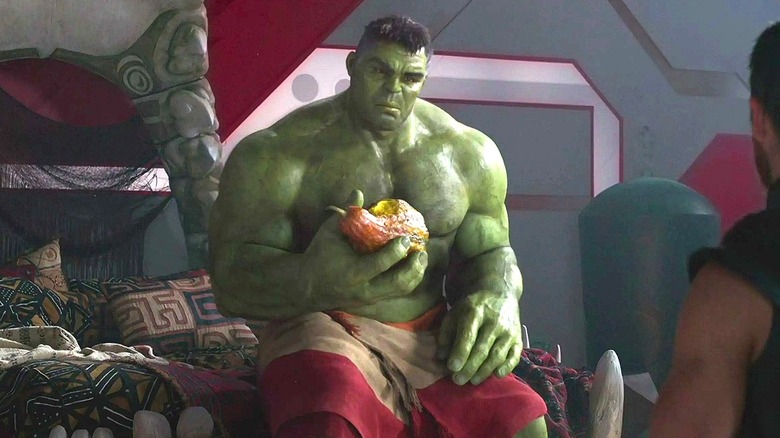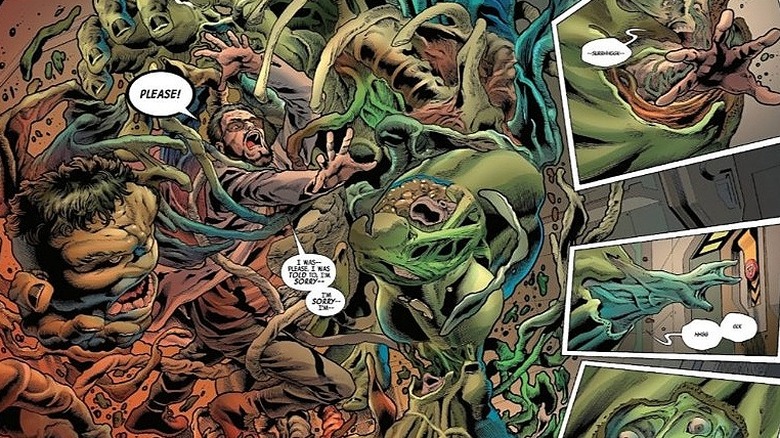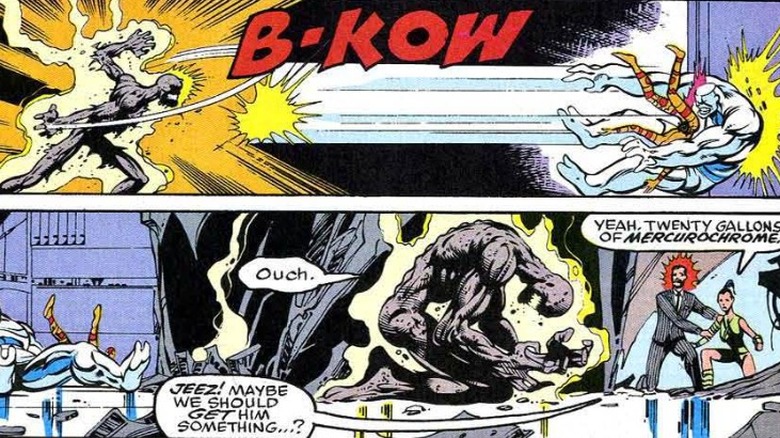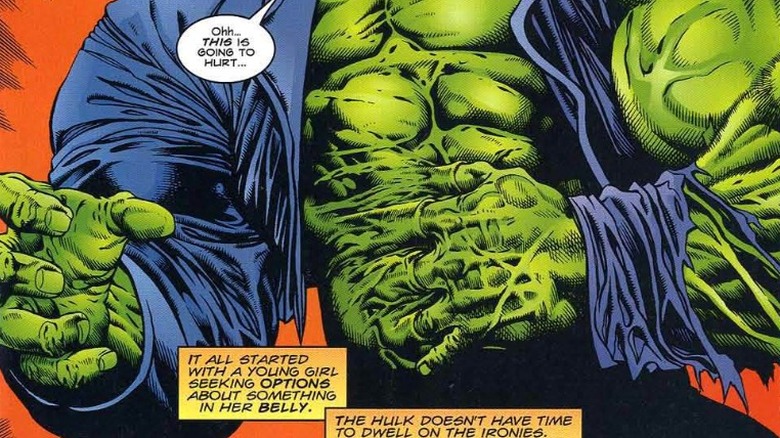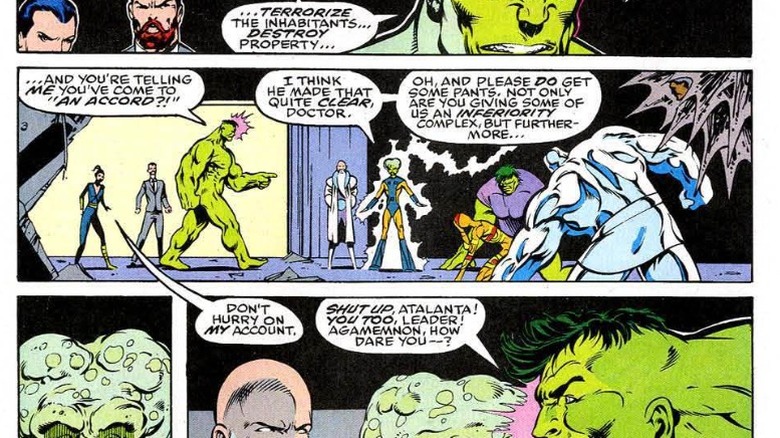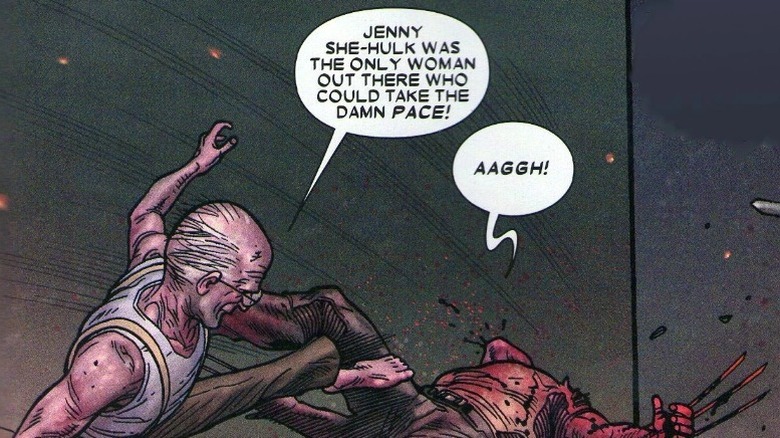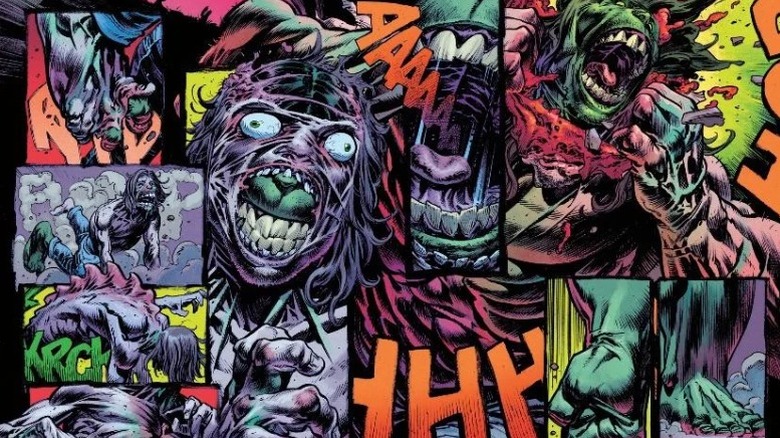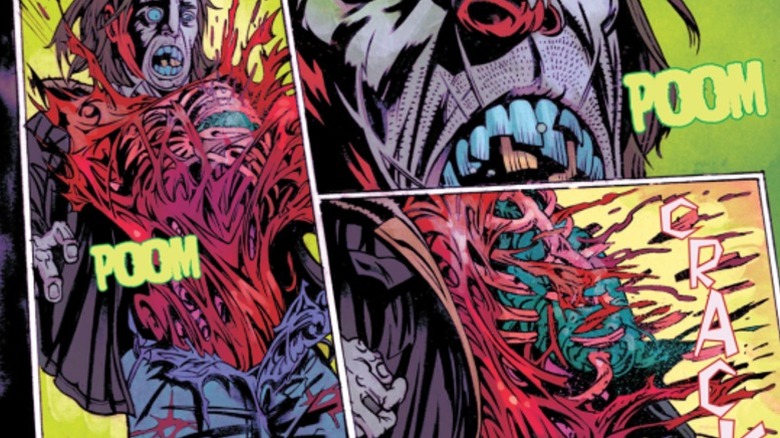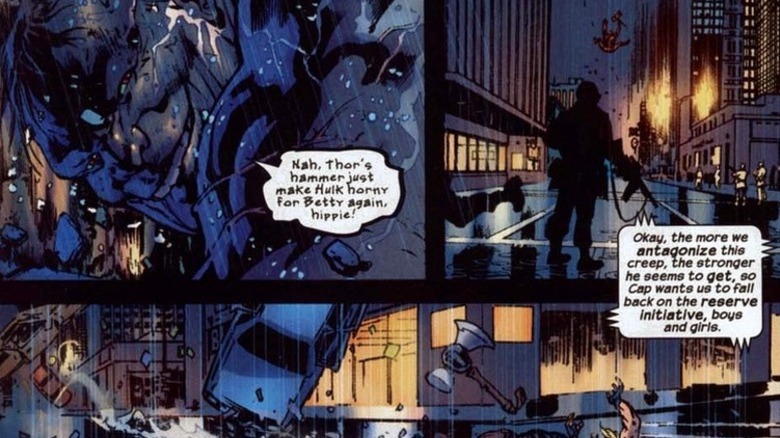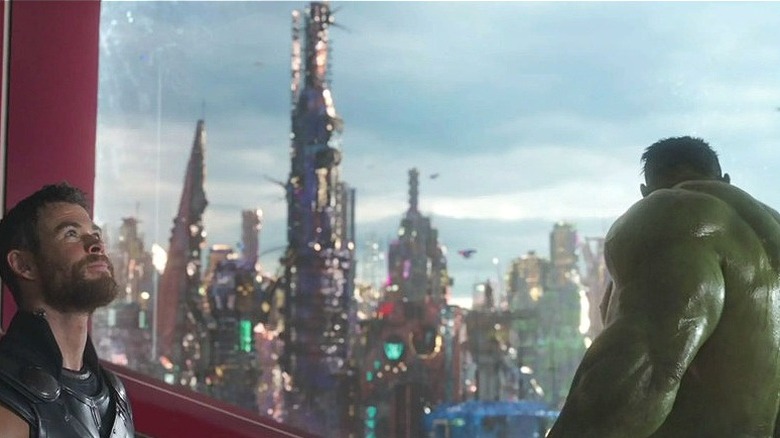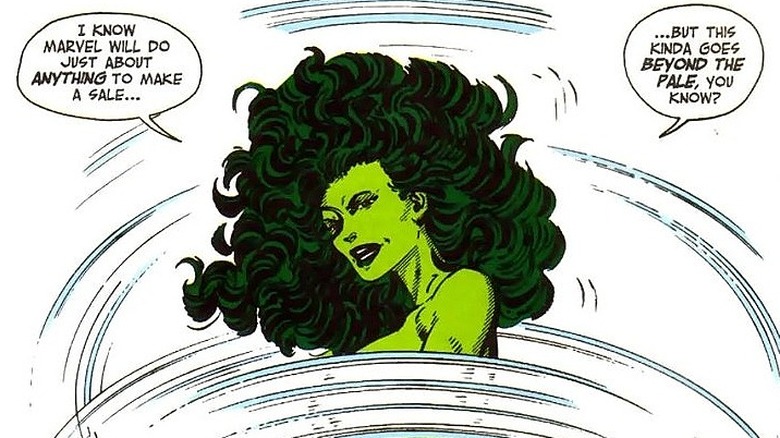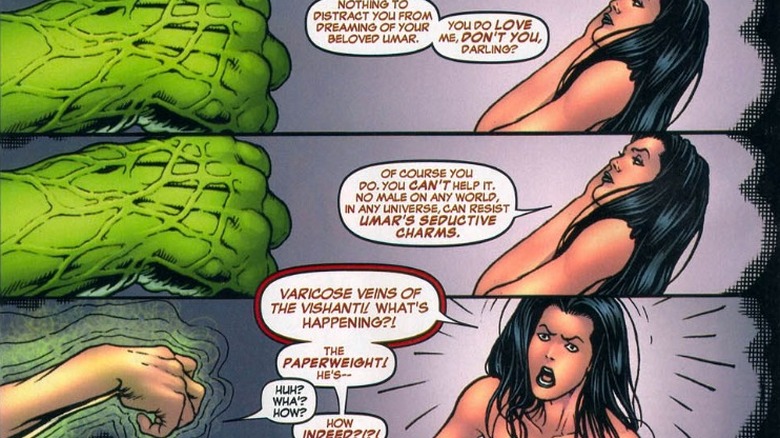11 Gross Facts About Hulk's Body That Only Adults Should Know
There are few characters in American media, let alone superhero comics, let alone Marvel lore, as legendary as the Hulk. Jack Kirby and Stan Lee were inspired by Frankenstein's monster and "Dr. Jekyll and Mr. Hyde" when creating the now-icon in 1962. The character has consistently captivated audiences around the world, effectively establishing a new fiction archetype of its own. Everyone knows the Hulk. Everyone loves the Hulk.
And yet, not everyone knows everything there is to know about the Hulk. A sticking point in the enduring cultural fascination with the Green Goliath stems from his anatomy — the sheer, alluring uncanniness of a scrawny nerd transforming into a massive green pile of muscles that can't be hurt by anything short of atomic bombs. The Hulk's classic imagery alone is iconic, with the seemingly indestructible purple pants that hide his anatomy just so, an improbable piece of fabric tethering the giant monster to recognizable humanity. It makes one wonder what's underneath those pants, and what are the nuts and bolts of his more general physiology.
The comics, for their part, have offered and/or recorded plenty of interesting information about the Hulk's body over the years, including several facts that could be described as not exactly safe for work, for either gross, gory, or racy reasons. Here are some of the most eyebrow-raising ones, which are sure to change the way you view the Hulk if you're not already familiar with them.
The Hulk can swallow you whole — but not with his mouth
Although the overall concept of the character has always teetered on the edge of horror, some of Marvel's many Hulks have pushed things further into outright scariness than others — but none have gone as far in that regard as "The Immortal Hulk," a 2018 series written by Al Ewing with illustrations by Joe Bennett. In "The Immortal Hulk," Bruce Banner confirms that, much to his chagrin, the Hulk is literally unkillable and will always regenerate and resurrect no matter the circumstances of his death.
In Issue #8 of the series, the implications of said immortality reach their grisly, horrifying peak. In this issue, a team of scientists is conducting experiments on the remains of Hulk's body, which has been hacked to bits and placed into different jars. At one point, experiment leader Dr. Clive learns that a task force led by Captain Marvel may soon thwart their plans, and, in a panic, he starts taunting the Hulk's various body parts about what the scientist team is going to do to them — causing them to respond by breaking free from the jars and swirling around Dr. Clive. Before he can do anything to save himself, the Hulk's body parts coalesce around him, completely engulfing the scientist in gamma-infused flesh as the regeneration process begins with the doctor inside the re-forming body. By the time the Hulk is whole again, Dr. Clive has been killed and absorbed into his form. David Cronenberg would be proud.
One time, the Hulk lost all of his skin — and it was disgusting
"The Incredible Hulk" legacy comic series that has been running almost continuously since May 1962 reached a particularly revelatory issue in 1992. At the time, the series' direction was in the hands of Peter David, who had begun scripting "The Incredible Hulk" comics in May 1987 and was responsible for several major character-changing decisions, including merging the green and grey Hulks along with Bruce Banner himself into a single being. Starting in July 1992, David's tenure dove into the four-part "Ghost of the Past" arc, penciled by Dale Keown, which followed the Hulk's conflict with the U-Foes and Samuel Sterns, aka the Leader.
In Issue #398, originally released on August 18, 1992, the Hulk engages in battle with the U-Foes at the Pantheon's headquarters. At one point, he directly fights the telekinetic Vector, who uses his matter acceleration powers to flay the Hulk. From a distance, he strips the Hulk of his clothes and then his skin while repelling the jade giant to keep him away — but the Hulk's strength outmatches Vector's repelling powers, allowing the massive hero to get close enough to land a punch that sends Vector flying across the room and knocks him out cold. However, the Hulk is left completely skinless, reduced to a writhing gray mass. It's a shocking sight to see him in such a vulnerable state — but it only takes a few seconds for his healing powers to kick in, immediately regenerating his skin and returning him back to normal.
Sometimes Hulk's body heals TOO fast
Speaking of regeneration, the ability of Hulk's body to heal from virtually any physical damage sometimes ends up being too powerful, to the degree that it creates entirely new problems for him. This becomes apparent in "The Incredible Hulk" #430.
A standalone issue written by Peter David and penciled by Liam Sharp, Issue #430 was published in April 1995. It follows a conflict between the Hulk and an old enemy, Speedfreek, who uses the Hulk to get to, and attempt to kill, a teenage boy responsible for the death of his daughter. During the fight that breaks out between the hero and villain, the latter manages to tear the Hulk's stomach open using adamantium blades, forcing Hulk to use his hand to press his belly shut and keep his organs from falling out. As it happens, his body's regenerative power is so strong and fast that his abdomen regenerates around his hand in those few seconds, leaving his left arm and upper body awkwardly fused together. This, in turn, forces him to painfully tear his hand out of his own stomach.
In a way, the occasional inconvenience of the ultra-fast healing is a microcosm for the Hulk's existential condition — he's blessed with incredible power, yet largely cursed with the inability to voluntarily control it and bend it to his will. It's hard not to glean some melancholy from the image of the character resigning himself to the pain he'll feel by violently freeing his hand from his own midsection.
The Hulk is humbling
As family-friendly as main-continuity Marvel Comics tend to be, it's pretty much inevitable that a character defined by his transformation into a massive, super-sized version of his human self would fuel audience speculation about the size of his penis. Indeed, it's one of the big questions that readers have been asking themselves about the Hulk for decades. But, in addition to obviously not showing it, Hulk comics have largely avoided the issue altogether, leaving only bits of information here and there for the especially inquisitive to piece together.
One of the rare instances in which readers got some confirmation about the size of Hulk's private parts came in 1992's "The Incredible Hulk" #398. It's the aforementioned issue in which Vector tears off the Hulk's skin — and the revelation in question happens just a few pages after that. Once the Hulk regenerates back into his normal, entire self, he is, naturally, naked. He's also ready to jump back into the fight, only for Agamemnon, the leader of the Pantheon, to stop him and tell him that won't be necessary as he and the Leader have reached a peaceful agreement. While the Hulk walks around the Mount and protests, the Leader asks him to put on pants, observing that the jade giant is giving some of the men present an inferiority complex. He also points out that there are women present — but Atalanta certainly doesn't seem to mind the view, saying from the sidelines, "Don't hurry on my account."
The Hulk is... vigorous... in bed
Although Hulk comics have historically avoided overt depictions of sex and open discussion of the size of the Hulk's genitalia, they certainly haven't shied away from openly discussing his sexuality. This has even played a major part in several storylines, as you'll note in this list's subsequent entries. After all, the idea of a stronger, more energetic, literally tireless version of Bruce Banner intuitively lends itself to questions about how that vigor translates to his performance in bed. And, as it turns out, the answer is "quite significantly."
Several stories over the years have portrayed the Hulk as having an especially vivacious sexual appetite, but in "Giant-Size Wolverine: Old Man Logan" #1, that vivacity crosses into outright ickiness. The issue, written by Mark Millar and illustrated by Steve McNiven, imagines Bruce Banner as a raving mad despot lording over a dystopian California, now dubbed "Hulkland" and controlled by the Hulk Gang — the various inbred offspring of the Hulk and his first cousin Jennifer Walters, aka She-Hulk.
At one point, while fighting Logan, the evil Banner defends himself from accusations that he's gone mad from the exposure to radiation, saying, "Who else was I gonna mate with besides my first cousin? Jenny She-Hulk was the only woman out there who could take the damn pace!" The comic doesn't clarify if Banner actually attempted "mating" with other women or merely considered the idea — but either way, it's a disturbing situation from all angles.
The Hulk's transformations have gotten grosser and grosser over the years
While the Hulk had his beginnings as a horror-tinged Marvel creation — he is, after all, a monster who takes over the body of an unwilling man — gear shifts in the comics over the decades ended up pulling him away from the realm of sheer monstrosity and towards a more palatable, more agreeable, and more conventionally sympathetic "angry giant hero" characterization. The consolidated model for Bruce Banner's transformation into the Hulk, seen in the classic 1978 TV series as well as all three of the character's 21st-century live-action cinematic iterations, thus became one in which he simply grows larger and turns green.
But that's not the only way for the metamorphosis to be portrayed, and the artists behind the Hulk's comics have become especially aware of that in recent years. Following the enormous success of "The Immortal Hulk," with its constant incursions into body horror and its general depiction of the Banner-Hulk nexus as a nightmare of pain, deformation, and grotesquerie, recent comics have veered towards depicting the Hulk as an entity that literally rips his way out of Bruce Banner, tearing him apart in the process in a way that calls to mind classic werewolf horror. Issue #6 of "The Incredible Hulk" volume 4, published in November 2023 with scripting by Phillip Kennedy Johnson and art by Nic Klein, is the perfect example of this, showing the Hulk gorily growing out of Banner, his head sprouting out of his alter ego's like the head of a snake in ecdysis. Ew.
A recent version of his transformation was literally stomach-churning
"The Incredible Hulk" volume 4, the re-numbered run of the "Hulk" written by Phillip Kennedy Johnson that has been going since 2023, has continually doubled down on the gruesomeness and gore — a trend that proceeded into 2024, with the release of the "Hulk: Blood Hunt" one-shot written by Johnson and illustrated by Danny Earls.
A tie-in with the massive "Blood Hunt" crossover event that pitted various Marvel characters against the threat posed by the newly-risen Vampire Nation, "Hulk: Blood Hunt" follows Bruce Banner as he wanders into the tiny ghost town of Old Tucson in his ongoing quest to rescue Charlie Tidwell's soul from the doll in which it's been trapped. Upon arrival, Banner finds that the town's only resident is a man named Miguel, and that there's a horde of vampires living underground. That setup alone is ripe for horror, but the most terrifying part of the one-shot arguably comes when Banner transforms into the Hulk.
In "Blood Hunt," the Hulk is shown as literally breaking open Banner's ribcage and bursting out of his chest — a process that Earls depicts in vivid, nightmarish detail. Much like many of the more extreme transformations in the current "Incredible Hulk" series, the Hulk's flesh-ripping, organ-ejecting emergence may be metaphorical — a reflection of how Banner feels when he's transforming — rather than an actual thing that's happening. Either way, it's literally stomach-churning stuff; it would seem that Horror Hulk is really here to stay.
Ultimate Hulk was an incredible horn-ball
One of the most notorious events in Marvel Comics history was the original run of "Ultimates," the series about the titular version of the Avengers with a membership made up exclusively of the characters' Ultimate Marvel iterations. In Volume 1 of "Ultimates," which was written by Mark Millar, penciled by Bryan Hitch, and ran between 2002 and 2004, Ultimate Hulk acts as a kind of villain. In this reality, Bruce Banner has long since successfully suppressed the Hulk, but when the Ultimates find themselves in desperate need of good publicity, he injects himself with a serum that turns him into a super-sized Hulk and goes on a rampage throughout New York City.
While most versions of the Hulk depict him as something of an eccentric manchild, "Ultimates" volume 1 reinterprets him as an unrestrained manifestation of Banner's repressed id. Among other things, this means that Ultimate Hulk is constantly, loudly, and ostentatiously sexual, not only constantly seeking out all the sexual interactions that Banner denies himself, but also persistently reiterating how horny he is to anyone who will listen. Having completely embraced amorality and sociopathy, he also doesn't seem all too concerned about consent. In one troubling story beat, he even implies that he intends to sexually assault Betty Ross as retaliation for her rejection of Banner. The Hulk has been many things across the years, but, aside from the Pappy Banner of "Old Man Logan" (also scripted by Millar), no other version of him has been quite this sleazy.
The Hulk's bare butt was a big first in the MCU
To an even greater degree than their comic book counterparts, the films in the Marvel Cinematic Universe are pointedly, strictly, and stringently family-friendly affairs. After all, if overtly adult content is avoided in legacy Marvel comics to avoid losing younger readers, that becomes an even bigger financial concern when it comes to blockbuster movies with massive budgets and billion-dollar box office expectations. One of the things this has meant, consistently, is a near-absence of sex and nudity in MCU films — it's rare to even see the characters so much as flirt with each other.
Incidentally, the Hulk was responsible for one big breach of that pattern: in the very first instance of a Marvel Cinematic Universe film getting away with nudity, his bare butt appeared in "Thor: Ragnarok" as part of one of a comedic scene spotlighting the awkward tension between the jade giant and Thor (Chris Hemsworth). Funnily enough, the closest the franchise had come to that prior to "Ragnarok" — before, indeed, the MCU was even officially a thing — also involved the Hulk, but in his human form, when "The Incredible Hulk" showed a sideways view of a nude Edward Norton as Bruce Banner. And, lest anyone accuse Taika Waititi of not being an auteur with personal style, the next instance of nudity in the MCU came when Chris Hemsworth starred in a revealing "Thor: Love and Thunder" moment — one not unlike the Hulk's in "Ragnarok."
She-Hulk's nudity has been played for laughs (and controversial commentary)
All the way back in 1992, the "Sensational She-Hulk" comic poked fun at readers' thirst by directly confronting their desire to objectify Jennifer Walters. At the time, some She-Hulk fans had spent years calling for the character to appear naked on the page — even though nudity of any kind and in any context would have been expressly prohibited by the Comics Code Authority.
To address the matter, "Sensational She-Hulk" #40, published in April 1992 with writing and art by John Byrne, featured a seemingly naked She-Hulk on the cover, covered only by a newspaper and the words "THIS IS IT! BECAUSE YOU DEMANDED IT!" written in boldface. Inside, the issue presents pages upon pages of She-Hulk jumping rope, apparently nude, with her private parts covered by blur lines. All the while, in a classic She-Hulk fourth wall break, she complains to the reader about having been forced to debase herself like this for the sake of comic sales, despite being a successful attorney and member of the Avengers.
Then, the comic's editor herself, Renée Witterstaetter, shows up and yanks out the rope from She-Hulk's hands, noting that Tom DeFalco (Marvel's editor-in-chief at the time) would never allow that sequence to see print if She-Hulk were really naked, prompting the reveal that she's been wearing underwear all along. She-Hulk, none the calmer, now worries about getting in trouble with the Better Business Bureau for false advertisement.
The Hulk was once de-Hulkified by sex
Generally speaking, in comic book storylines that address the Hulk's sexuality more directly, such as the Mark Millar-scripted first volume of "Ultimates," sex is depicted as a typically intense, boisterous, and animalistic activity for the character, an expression of the Hulk's aggressive nature and lack of restraint. But, in at least one instance, sex has been depicted as antithetical to the Hulk's demeanor — so antithetical, in fact, as to render Bruce Banner incapable of hulking out at all.
As depicted on the third issue of the 2005-2006 "Defenders" miniseries, written by Keith Giffen and J.M. DeMatteis with art by Kevin Maguire, when Umar the Unrelenting takes the Hulk as her prisoner, she decides to bed her new "paperweight." They have sex, and it is so pleasurable and satisfying for the Hulk that, rather than enhance his aggressiveness, it relaxes him, transforming him back into Bruce Banner. What's more, Banner feels so relaxed after having sex with Umar that he then finds himself unable to change back into the Hulk, no matter what he or Umar does.
Not only did Umar sleep with Hulk and survive, but she also went back for another round. Years later, in the Greg Pak-scripted and Paul Pelletier-penciled "Incredible Hulks" #633, Umar was depicted as once again overpowering the Hulk, taking him back with her to the Dark Dimension as her personal consort. This time, however, the Hulk seemingly had no problem maintaining his green form throughout their sessions of intimacy.
